If you’re a bird enthusiast or simply someone who appreciates nature’s vibrant colors, you’ll be delighted to know that Georgia is home to a diverse range of yellow birds.
These feathered beauties add a splash of sunshine to our gardens, parks, and forests, captivating our senses with their cheerful melodies and striking plumage.
From the iconic American Goldfinch to the elusive Prothonotary Warbler, Georgia’s avian diversity offers a visual feast for birdwatchers and nature lovers alike.
Whether you’re an experienced birder or just starting to explore the fascinating world of ornithology, this guide will introduce you to some of the most stunning yellow birds that grace our state.
So keep reading to learn more about the diverse yellow avian species found across the state.
Types of Yellow Birds in Georgia
Here are the top 20 types of yellow birds found in Georgia.
American Goldfinch – Spinus tristis
The American Goldfinch is a true avian gem, instantly recognizable by its vibrant yellow body and striking black cap and wings.
These lively birds are a common sight in Georgia, frequenting fields, parks, and backyard feeders. With their delightful song and acrobatic flight patterns, they bring joy to birdwatchers and nature enthusiasts alike.

During the breeding season, the male American Goldfinch dons a brilliant lemon-yellow plumage that stands out against the greenery.
Females, though less vibrant, sport a more subdued olive-yellow color. Both sexes share the distinctive black cap, wings, and tail feathers, creating a beautiful contrast.
These social birds often travel in small flocks, chattering and flitting from plant to plant, feeding on seeds from thistles, sunflowers, and other vegetation.
Their unique ability to extract seeds from tough seed heads makes them a valuable part of the ecosystem, helping to disperse and propagate various plant species.
You May Also Like – 6 Types of Egrets in Florida
Black-throated Green Warbler – Setophaga virens
The Black-throated Green Warbler is a stunning migratory bird that graces Georgia’s forests during the breeding season.
With its olive-green back, bright yellow face and underparts, and distinctive black throat, this warbler is a sight to behold among the leafy canopies.
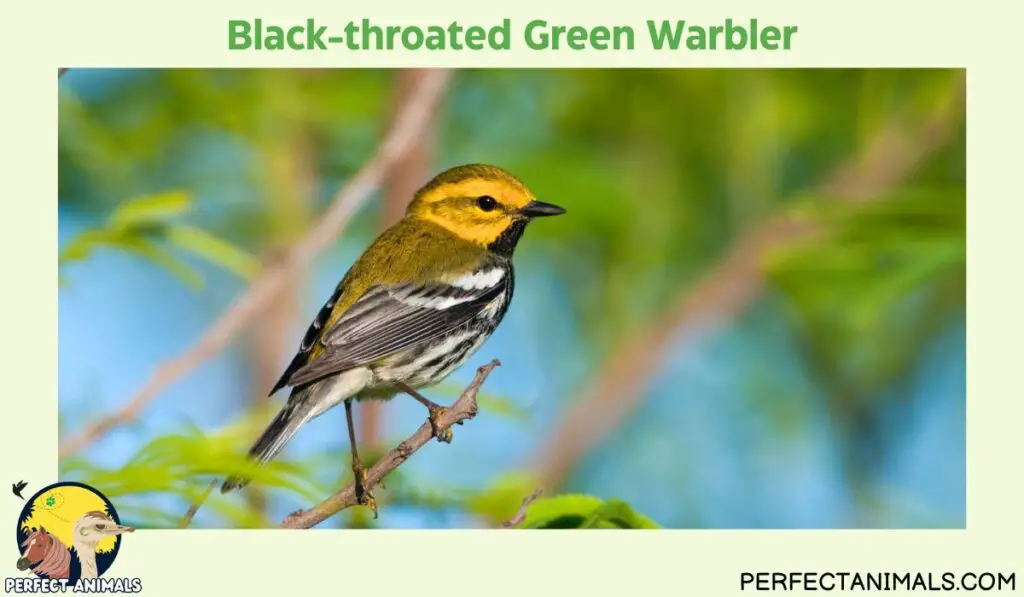
These agile warblers are expert foragers, skillfully gleaning insects from the bark and foliage of trees. Their high-pitched song, often described as a buzzy “zee-zee-zee-zoo-zee,” can be heard echoing through the woodlands, adding to the ambiance of a peaceful nature walk.
During migration, Black-throated Green Warblers can be spotted in parks, gardens, and even urban areas, making brief stopovers to refuel before continuing their journey.
Their presence is a reminder of the importance of preserving natural habitats for migratory species.
Pine Warbler – Setophaga pinus
The Pine Warbler is a year-round resident of Georgia’s pine forests, where its bright yellow plumage and distinctive trills add a touch of cheer to the evergreen landscapes.
These energetic warblers are often seen foraging along the trunks and branches of pine trees, expertly probing the bark for insects and spiders.
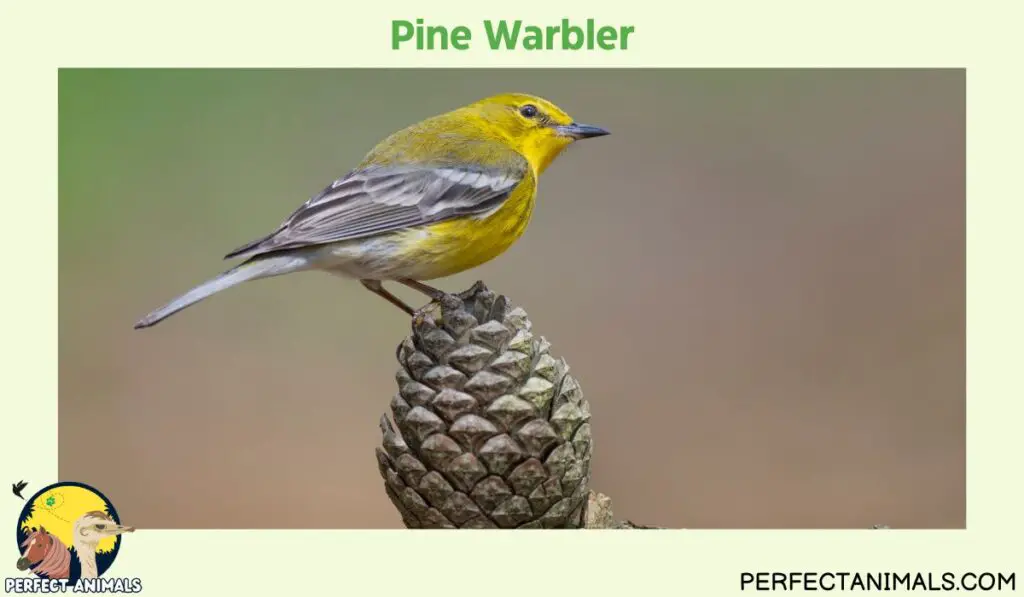
With their olive-green backs, yellow breasts, and unique behavior of climbing up and down tree trunks like nuthatches, Pine Warblers are a delight to observe.
Their cheerful songs, comprised of a series of clear, tinkling notes, can be heard throughout the pine forests, adding to the natural symphony.
During the breeding season, Pine Warblers construct their nests on the branches of pine trees, cleverly camouflaging them with bits of bark and lichen.
These resourceful birds play an important role in controlling insect populations within their pine-dominated habitats.
You May Also Like – 10 Eye-catching Birds With Red Heads
Baltimore Oriole – Icterus galbula
The striking Baltimore Oriole is a seasonal visitor to Georgia, arriving in spring to breed and delight birdwatchers with its brilliant orange and black plumage.
These neotropical migrants are true harbingers of summer, their rich, flutelike whistles heralding the arrival of warmer days.
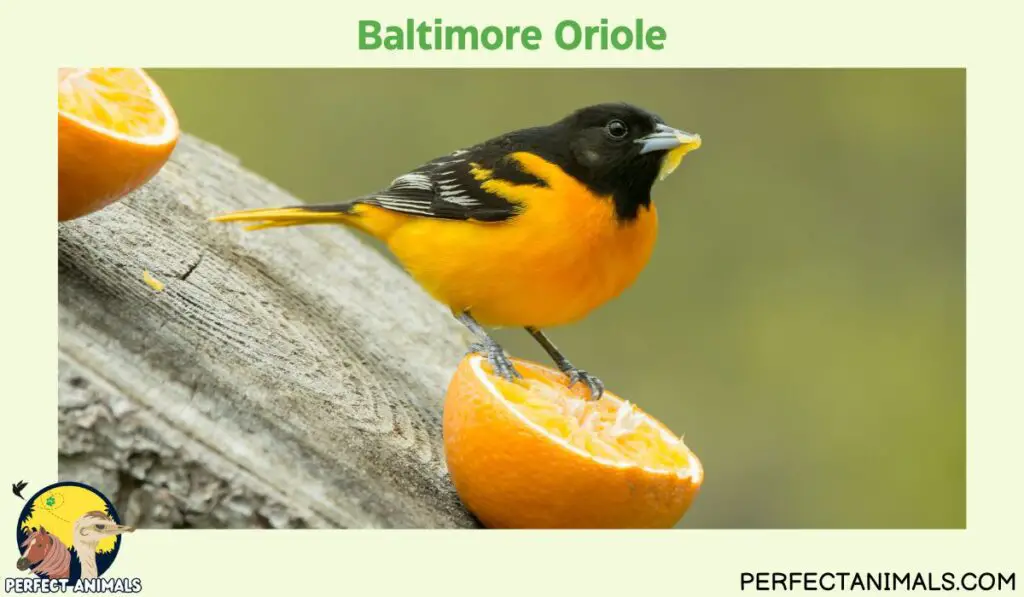
Male Baltimore Orioles are unmistakable with their vibrant orange bodies, contrasting black head and wings, and distinctive white wing bars.
Females, though less flamboyant, sport a more subdued yellow-orange coloration with grayish accents.
These skillful architects weave intricate hanging nests, suspending them from the branches of tall trees.
Baltimore Orioles are primarily fruit and insect eaters, playing an important role in controlling pest populations and dispersing seeds through their foraging activities.
Prothonotary Warbler – Protonotaria citrea
The Prothonotary Warbler is a true jewel of Georgia’s wetlands and bottomland forests. With its stunning golden-yellow plumage, accented by bluish-gray wings and back, this warbler is a sight to behold as it flits among the lush vegetation near water sources.

These vibrant warblers are expert insect hunters, skillfully gleaning their prey from the bark of trees and shrubs.
Their rich, ringing songs fill the air, adding to the serene ambiance of their watery habitats. Prothonotary Warblers are also known for their unique nesting habits, often utilizing abandoned woodpecker cavities or nest boxes placed near streams and swamps.
As migratory birds, Prothonotary Warblers face threats from habitat loss and degradation, making conservation efforts crucial for their survival.
Their presence in Georgia’s wetlands is not only a delight for birdwatchers but also an indicator of a healthy, thriving ecosystem.
You May Also Like – Meet the Top 10 Birds With Long Beaks
White-eyed Vireo – Vireo griseus
The White-eyed Vireo is a lively and inquisitive songbird that frequents Georgia’s thickets, scrublands, and woodlands.
With its olive-green back, yellow breast, and distinctive white eye-ring, this vireo is a delightful addition to the state’s avian community.
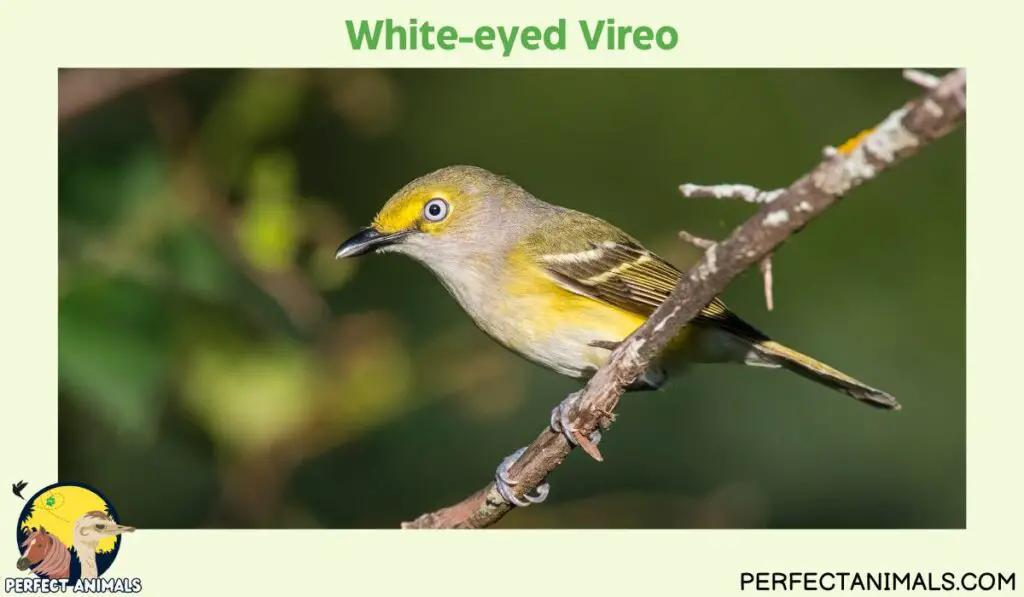
Despite its small size, the White-eyed Vireo is a vocal powerhouse, delivering a rapid-fire series of harsh, scolding notes that can be heard echoing through the undergrowth.
These energetic birds are constantly on the move, hopping from branch to branch in search of insects and berries.
During the breeding season, White-eyed Vireos construct intricate cup-shaped nests, carefully concealing them within dense foliage.
Their presence in Georgia’s shrubby habitats plays a crucial role in controlling insect populations and promoting a healthy ecosystem.
Common Yellowthroat – Geothlypis trichas
The aptly named Common Yellowthroat is a vibrant warbler that can be found in Georgia’s wetlands, marshes, and overgrown fields.
With its bright yellow throat and chest, contrasted by a striking black mask, this warbler is a true standout among the reeds and cattails.
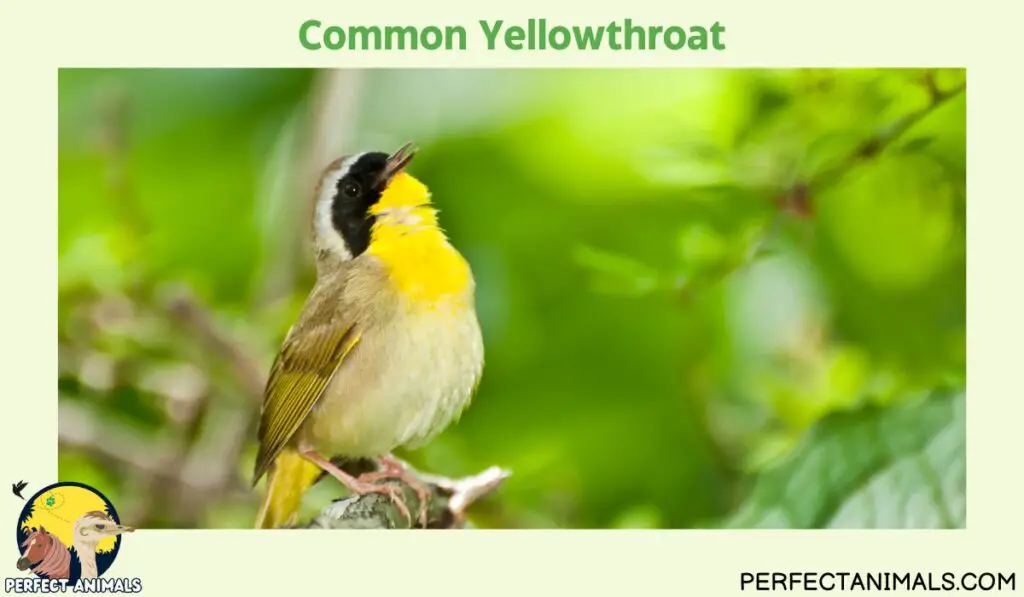
These secretive birds are often heard before they are seen, their distinctive “witchy-witchy-witchy” song emanating from the dense vegetation they call home.
Common Yellowthroats are skilled foragers, adeptly searching for insects and spiders among the tangled stems and leaves.
During the breeding season, males establish territories and engage in aerial displays to attract mates.
Their well-camouflaged nests, woven among the grasses and sedges, provide a safe haven for their young, ensuring the continuation of this vibrant species in Georgia’s wetland habitats.
You May Also Like – 10 Amazing Birds With Long Legs
Yellow Warbler – Setophaga petechia
The cheerful Yellow Warbler is a familiar sight in Georgia’s woodlands, parks, and gardens during the breeding season.
With its bright yellow plumage and intricate chestnut-streaked breast, this lively warbler adds a touch of sunshine to any outdoor space it graces.
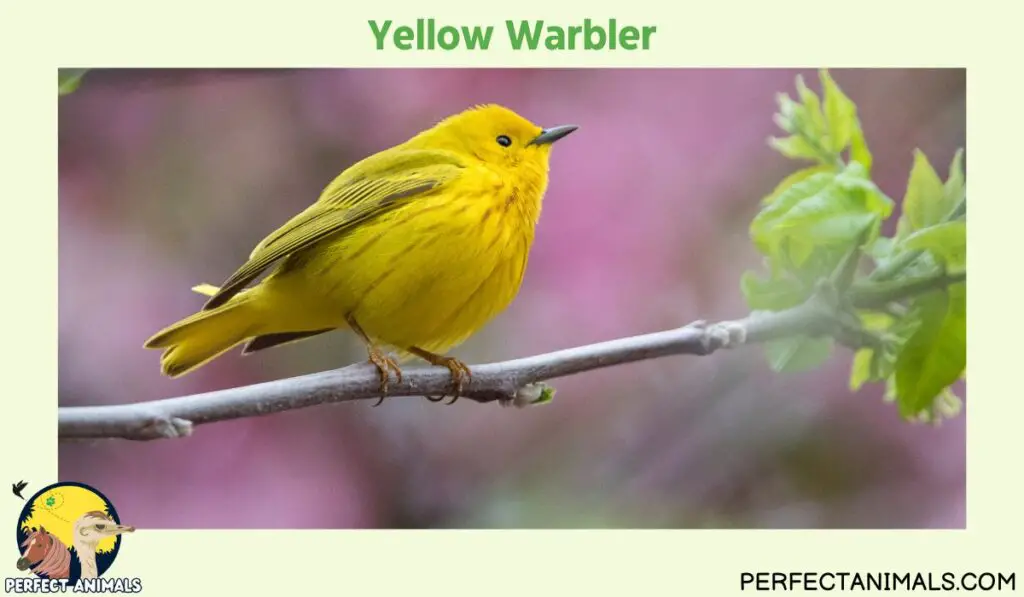
Known for their distinctive “sweet-sweet-sweet” song, Yellow Warblers are constantly on the move, foraging for insects among the foliage.
Their agility and energetic nature make them a delight to observe as they flit from branch to branch, never staying still for long.
These skillful nest builders construct intricate cups, often incorporating plant down, spider webs, and even bits of string into their creations.
Yellow Warblers play a crucial role in controlling insect populations, making them valuable allies in maintaining healthy ecosystems.
Yellow-throated Warbler – Setophaga dominica
The Yellow-throated Warbler is a stunning resident of Georgia’s mature forests, where its distinctive plumage and melodious song add vibrancy to the woodland landscapes.
With its blue-gray back, bright yellow throat, and distinctive black facial markings, this warbler is a true standout among the leafy canopies.
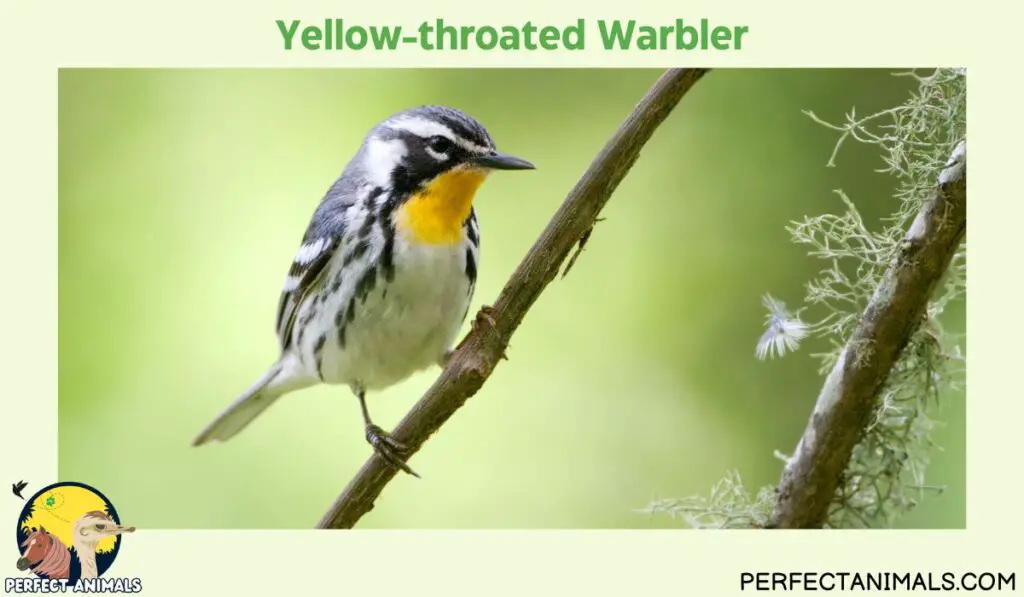
These agile birds are expert foragers, skillfully gleaning insects from the bark and foliage of trees.
Their rich, musical songs, often described as a series of whistled notes interspersed with buzzy trills, create a soothing ambiance in the forest understory.
During the breeding season, Yellow-throated Warblers construct their nests high up in the branches of deciduous trees, carefully weaving together bark strips, moss, and other plant materials.
Their presence in Georgia’s mature forests is a delight for birdwatchers and an indicator of a healthy, well-established ecosystem.
You May Also Like – 12 Clever Birds That Eat Spiders
Hooded Warbler – Setophaga citrina
The striking Hooded Warbler is a true gem of Georgia’s deciduous forests, where its distinctive yellow face, framed by a black hood, makes it a standout among the greenery.
With its olive-green back and yellow underparts, this warbler is a sight to behold as it flits through the understory.
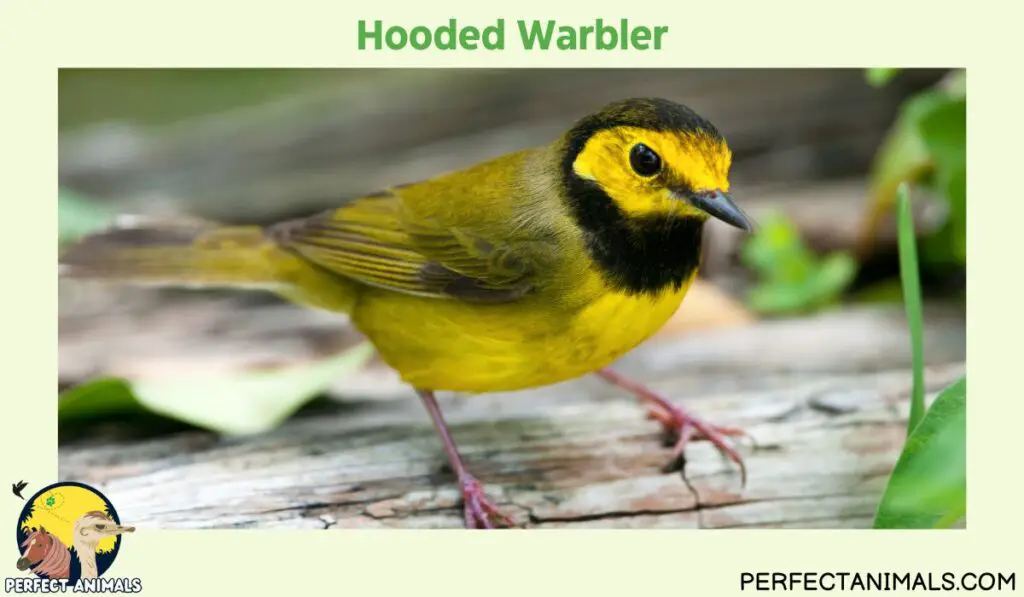
These energetic birds are constantly on the move, foraging for insects and spiders among the leaf litter and low-lying vegetation.
Their rich, ringing songs, often described as a series of high-pitched whistles, add to the natural symphony of the forest.
During the breeding season, Hooded Warblers construct their nests on or near the ground, cleverly concealing them among the fallen leaves and vegetation.
Their presence in Georgia’s mature woodlands is not only a delight for birdwatchers but also plays a crucial role in maintaining a healthy ecosystem.
Prairie Warbler – Setophaga discolor
The Prairie Warbler is a vibrant and energetic inhabitant of Georgia’s scrublands, overgrown fields, and brushy areas.
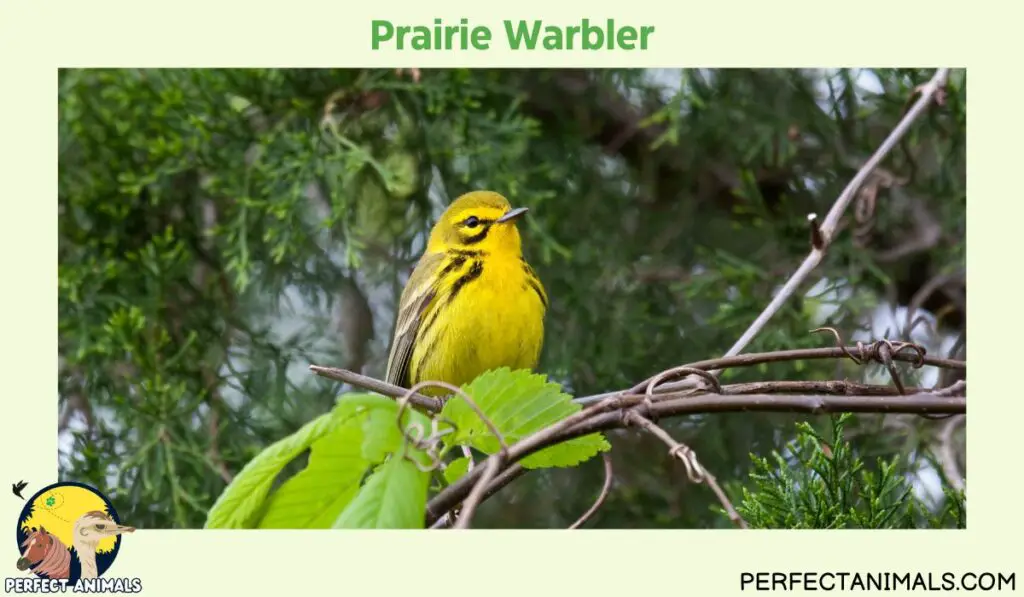
With its bright yellow underparts, olive-green back, and distinctive black streaks on its sides, this warbler is a true standout among the dense vegetation it calls home.
These active birds are constantly on the move, foraging for insects and spiders among the tangled branches and foliage.
Their rich, ringing songs, often described as a series of buzzy trills and whistles, fill the air with their cheerful melodies.
During the breeding season, Prairie Warblers construct their nests low to the ground, carefully concealing them among the grasses and shrubs.
Their presence in Georgia’s open and shrubby habitats is not only a delight for birdwatchers but also plays a crucial role in maintaining a healthy ecosystem.
You May Also Like – What Does It Mean When a Bird Hits Your Window?
Dickcissel – Spiza Americana
The Dickcissel is a striking grassland bird that graces Georgia’s prairies, pastures, and fallow fields during the breeding season.
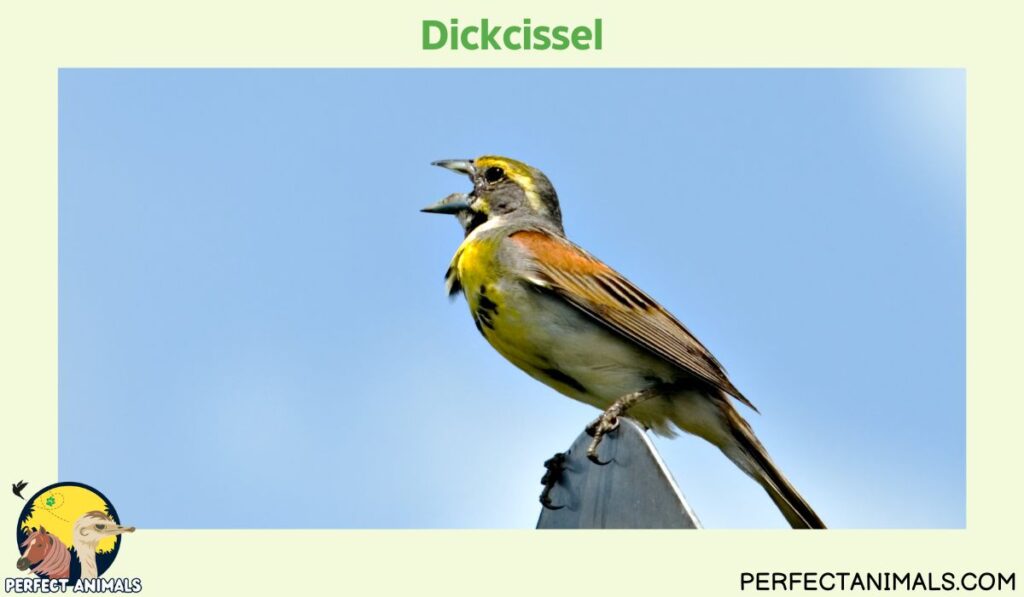
With its distinctive black V-shaped bib, yellow breast, and streaked brown back, this sparrow-like bird is a true standout among the grassy landscapes it inhabits.
These energetic birds are often heard before they are seen, their buzzy songs, described as a series of dry chips and rasps, filling the air with their unique melodies.
Dickcissels are primarily seed and insect eaters, foraging among the tall grasses and wildflowers.
During the breeding season, males establish territories and engage in aerial displays, fluttering, and singing to attract mates.
Their well-camouflaged nests, woven among the grasses and forbs, provide a safe haven for their young, ensuring the continuation of this vibrant species in Georgia’s grassland habitats.
Magnolia Warbler – Setophaga magnolia
The Magnolia Warbler is a stunning neotropical migrant that graces Georgia’s woodlands during spring and fall migrations.
With its bold yellow breast, streaked black and white flanks, and distinctive gray crown and white wing patches, this warbler is a sight to behold as it flits among the branches.
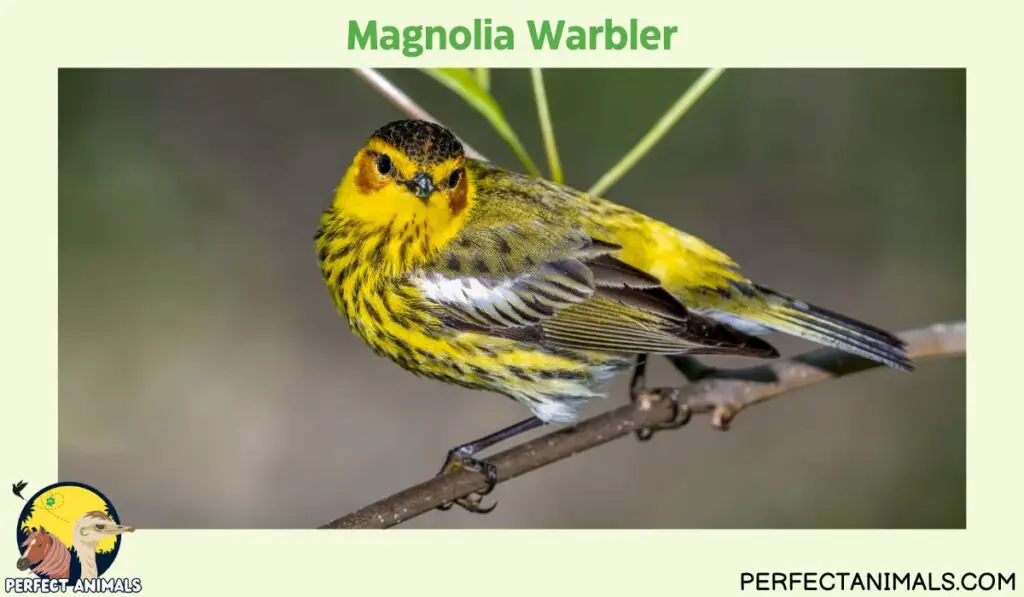
These active warblers are expert foragers, gleaning insects from the bark and foliage of trees with their slender, curved beaks.
Their rich, melodious songs, often described as a series of high-pitched whistles and trills, add to the natural symphony of the forests during their brief stopovers.
While in Georgia, Magnolia Warblers can be spotted in parks, woodlands, and even urban areas with mature trees, making the most of these stopover sites to refuel before continuing their long journey.
Their presence is a reminder of the importance of preserving natural habitats for migratory species.
You May Also Like – Can You Keep A Cardinal As A Pet?
Final Thoughts
Georgia’s diverse landscapes host an incredible array of vibrant yellow birds, from the iconic American Goldfinch to the elusive Prothonotary Warbler.
As we’ve explored these feathered marvels, it’s clear that each species plays a vital role in maintaining healthy ecosystems through seed dispersal, insect control, and adding natural soundscapes.
Appreciating and protecting these beautiful avian ambassadors is not only a responsibility but a privilege.
By preserving their habitats and promoting sustainable practices, we can ensure future generations experience the joy of witnessing Georgia’s yellow bird diversity firsthand.
I hope you’ve enjoyed learning about Georgia’s amazing yellow birds!
Resources – (for further reading)
eBird – American Goldfinch, Yellow Warbler Setophaga petechia, Yellow-throated Warbler Setophaga dominica
All About Birds – Black-throated Green Warbler Identification, Prairie Warbler
Wikipedia – White-eyed vireo, Magnolia warbler

Brittney , a devoted exotic pet enthusiast, showcases her profound passion for the animals through her role as a veterinary technician. With a strong background in caring for a diverse array of animals, she shares her expertise by crafting engaging articles about exotic pets for our blog.

